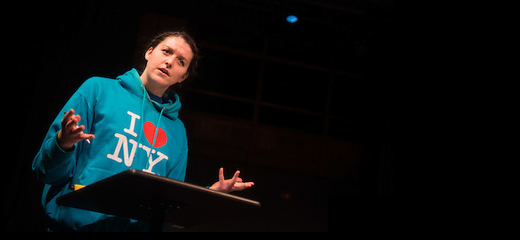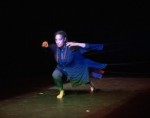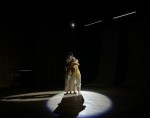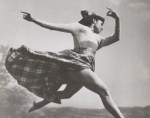
Photo: JJ Tizou
ELEANOR! Is Us
by Jonathan Stein
When a performing artist titles her piece with her first name, in caps, and then adds an exclamation point, you have to worry if she is perched over a precipice of narcissistic annihilation.
But having gotten our attention at ELEANOR!, the tall and charming Eleanor Bauer, decked out in an I Love New York hoodie, assures us from the performance get-go that her show is “not about me” but about her audience—“a shared reality.” And although the evening’s thread is self-referential, an animated monologue of Bauer’s travails as a young performing artist with bases in Brussels and New York City, she shapes an engaging communal experience of mutually experienced joys, challenges and horrors. (The shared experience also extended to this writer, who hosted her during her stay in Philadelphia, allowing time for a lively dialogue with the artist. See italicized sections.) Bauer’s lecture performance is stand-up comedy but with truths that may hit too deeply for sustained laughter, at least for the first night’s audience on a cold mid-week January evening. (She reported a warmer audience reception the second night.)
After personally greeting and shaking hands with every one of the estimated 70 people in the audience, Bauer conducts an extended demographic audience survey that confirms her feeling that performances are seen primarily by fellow artists, performers and their close friends or partners dragooned into coming along. Discovering two “outsiders” in her survey, she sends enthusiastic love out to the two lawyers in the audience who somehow found their way to ELEANOR!, encouraging them to come back with lots of friends.
Her survey method bonds her to her audience for what becomes an airing of the conflicts between producing art and surviving as an artist, where artistic creation becomes a business, and survival an art. Ever upfront with her process—and in your face with her delivery—Bauer attributes as the source for her comic rant the essay by the Belgian philosopher Dieter Lesage,
Portrait of the Artist as a Worker. She initially created ELEANOR! in 2005 (upon her arrival in Brussels at age 20) and expanded it over years; it addresses with understanding and irony the almost insane multiplicity of lives and activities artists must pursue today. In the piece, Bauer ticks off the eleven part-time jobs she pursued concurrently in New York City after her 2003 graduation from the NYU Tisch School of the Arts.
Bauer investigates the life of the dance artist and art-making today in a political economic setting, where “everything you do is for trade or sale,” and where selling T-shirts with the brand name ELEANOR across them (of course) is the key to generating the income that neither presenters nor box-office will. In fact, the audience member (a local actor) who raised his hand the most times in her survey of currently-held jobs is rewarded with just such a t-shirt. She addresses the psychological roles that passion for the work and the need for recognition play. These requisites, along with money, comprise her “tri-partite theory of the economies of the art world.” She observes that “instead of exchanging money, accolades or appreciation are what fuels the dance community.”
ELEANOR! is a thing that keeps popping up periodically… I revisit it, I revise it… I keep revising it… it’s a piece that can take adaptation which is fun. I’ve kind of expanded on it as I learned more, observed more, and have more reflections on how the dance field is operating and supporting itself. It’s something I can keep adapting and adding stuff to. That’s nice.
ELEANOR! brings to mind other efforts to make solo work around the dancer’s work and life, such as in Jérôme Bel’s documentary
Véronique Doisneau (2004), of a Paris Opera Ballet corps dancer, and in his live work
Cédric Andrieux (2009), with a former Cunningham and Lyons Opera Ballet dancer. But whereas Bel’s focus is to give a voice to the often voiceless dancer in an elite company (in
Doisneau), or to explore the interior life of the dancer and relationship with the choreographer (in
Andrieux, seen in 2010 at the
Live Arts Festival in Philadelphia), Bauer has both larger political and more intimate psychological interests, including bonding with fellow artists. She also inserts highly acidic and comedic content into her work.
I made this piece before I knew what a lecture presentation was and I made it in my first month having moved to Europe. I was hardly aware of Jérôme Bel. In 2004, he was someone I had yet to learn about. I knew the world of New York artists—different world. I wasn’t consciously trying to place ELEANOR! in any lineage like that… What you [Stein] said today made sense to me, this piece is less like a framed theatrical-type precise portrait, and more of like a leaky, sprawling, hanging-out with the audience work [laughs], it gets ad-libbed every time I perform it—I come up with a new riff that I want to add to the piece. It’s constantly evolving and trying actively to be in context with the audience in front of me with the various tactics built into the piece, but also in just talking to them and learning from them, and adding to the piece because of them—something I’ve enjoyed allowing it to be, just like an endless work in progress.
The questions and issues that arise out of the making and presenting of her art itself become the subjects of Bauer’s dance pieces. In her Philadelphia debut in early 2012 in
(BIG GIRLS DO BIG THINGS), she explored a gamut of issues in her bizarre and endearing performance in an outsized bear fur costume: issues of perception and audience expectations, of the performer’s ego and the role of entertainer, of thinking and being big—in scale and in hubris. A highly articulate observer of her own life and work (see
her interview with Gia Kourlas for
BIG GIRLS), Bauer does not shy away from a tumbling discourse into the multiplicities of art-making as generative of performance. Her newest work, at this week’s American Realness Festival in New York,
Midday & Eternity (the time piece) also finds its sources in the daily work of artistic practice
.
Yes, the time piece is about practice, daily practice, I’m thinking about dance as something that is a work in progress always. Even if you choreograph the most fixed piece, it is something you have to repeat in order to maintain—how the details can open up worlds of experience and reflection, and about just the modesty of being a craftsman, or a worker, or a practitioner… It’s a dance piece, a dance piece about dance. More broadly it’s about my aversion towards metaphor and representation with dance… It’s an experiential, ephemeral now and not later, it is what it is and that’s what it is—in the words of James Brown [There It Is (1972)].
Bauer concludes ELEANOR! with a short, eclectic dance segment repeated four times, an explosion of frenetic runs, arm gestures and head and hair swings that she described to me afterwards as having been an intuitive response to the text, made at a time when she “didn’t have a conceptual relationship to making dance consciously.”
When I made it I honestly didn’t know what I was doing, after the fact I did recognize what this phrase had to do with the text. I took for granted that what I was making in this mindset was going to be pertinent, that it belongs together because I’m the context that frames it… I would put things together that made sense together and then as I looked at them I would understand why they made sense together… It’s funny, it’s something I sort of wanted to get back to but don’t know how, it feels naïve to me. I actually lost that—I can’t be blind anymore to knowing what things have a relationship to each other or anticipating or deciding what the method is before I even go into the studio.
The dance at the conclusion of ELEANOR! is an exorcism of the artist’s travails and an affirmation that in the end, there’s just the dance, which speaks for itself.
ELEANOR! presented by thirdbird at Christ Church Neighborhood House, Jan. 10-11.
By Jonathan Stein
January 17, 2014











